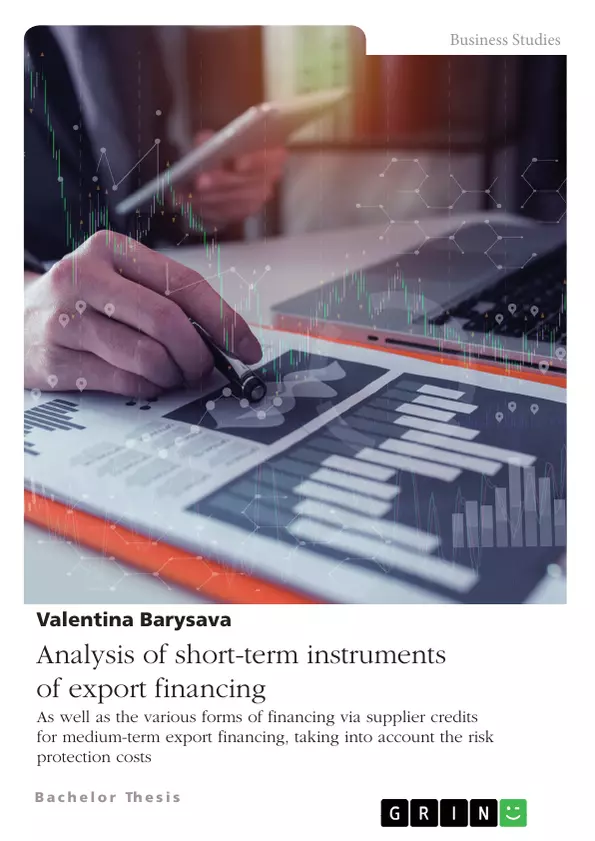This Bachelor thesis is aimed at all exporters who are interested in doing business with Belarus and who want to inform themselves about the coverage of del credere risks and export financing because export financing is nowadays expected as part of the offer. Consequently, the aim of this work is to examine the instruments of short-term export financing and the forms of medium-term financing, taking into account the risk hedging costs for decision-making in export business with Belarus. The risks are covered by export credit guarantees issued by the Federal Republic of Germany. Export financing is provided through supplier credits for the purposes of competitive differentiation. All instruments examined were used to refinance supplier credits. Such decision methods as cost comparison and SWOT analysis are used to determine the appropriate instrument. After the SWOT analysis, risks, opportunities and such important criteria as security, liquidity inflow, creditworthiness requirements and administrative expenses are assessed. The use of the SWOT analysis reduces the probability of a risk or opportunity miscalculation and thus of a wrong decision.
Inhaltsverzeichnis (Table of Contents)
- Introductory remarks
- Initial situation and problems
- Goal of the work and personal motivation
- Delimitation of the topic
- Procedure
- Theoretical basics
- Methodology of work
- Definition of important terms
- Euromarket financing
- Acceptance credit
- Export factoring
- Forfaiting
- State export credit insurance
- OECD and Berne Union regulations
- Forms of coverage by the waistband
- Supplier credit cover
- Manufacturing risk cover
- Short-term financing. cost comparison
- General starting position
- Costs of the Hermes cover
- Overdraft costs
- Acceptance credit costs
- Costs of export factoring
- Comparison of costs
- Short-term financing. SWOT analysis
- Overdraft facility
- Acceptance credit
- Export factoring
- Comparison of the results of the SWOT analysis
- Medium-term financing. cost comparison
- General starting position
- Hermes coverage costs
- Equity financing
- Debt financing
- Forfaiting
- Comparison of costs
- Medium-term financing. SWOT analysis
- Equity financing
- Debt financing
- Forfaiting
- Comparison of the results of the SWOT analysis
- Summary
Zielsetzung und Themenschwerpunkte (Objectives and Key Themes)
This Bachelor thesis is designed to provide exporters with comprehensive information about del credere risk coverage and export financing options, particularly for businesses looking to engage with Belarus. It aims to examine the instruments of short-term and medium-term export financing, taking into account risk hedging costs in relation to export business with Belarus. This analysis focuses on the use of export credit guarantees issued by the Federal Republic of Germany.
- Examination of short-term and medium-term export financing instruments for businesses with Belarus.
- Analysis of risk hedging costs associated with export financing, focusing on the use of export credit guarantees.
- Evaluation of different financing options for supplier credits, aiming to provide insights for exporters.
- Application of decision-making tools such as cost comparison and SWOT analysis to assess and select appropriate financing instruments.
- Exploration of factors such as security, liquidity inflow, creditworthiness requirements, and administrative expenses in the context of export financing.
Zusammenfassung der Kapitel (Chapter Summaries)
- Introductory remarks: This chapter introduces the topic of the thesis, outlining the current situation and challenges facing exporters, especially those dealing with Belarus. It further defines the goals of the research and personal motivation behind it, alongside the delimitation of the topic and the methodological approach taken.
- Theoretical basics: This chapter provides a foundational understanding of the theoretical concepts relevant to the thesis, covering the methodology of work, definitions of crucial terms, and an overview of Euromarket financing, acceptance credit, export factoring, and forfaiting.
- State export credit insurance: This chapter explores the regulations set by the OECD and Berne Union regarding state export credit insurance, examining the different forms of coverage offered, particularly focusing on supplier credit cover and manufacturing risk cover.
- Short-term financing. cost comparison: This chapter analyzes the costs associated with various short-term financing instruments, including the Hermes cover, overdraft facilities, acceptance credit, and export factoring. It compares these costs to help exporters make informed decisions.
- Short-term financing. SWOT analysis: This chapter examines the strengths, weaknesses, opportunities, and threats associated with short-term financing options such as overdraft facilities, acceptance credit, and export factoring. It compares the findings of the SWOT analysis for each instrument to provide a comprehensive assessment.
- Medium-term financing. cost comparison: This chapter focuses on the costs associated with medium-term financing options, including Hermes coverage, equity financing, debt financing, and forfaiting. It compares the cost implications of each option to aid in decision-making.
- Medium-term financing. SWOT analysis: This chapter examines the strengths, weaknesses, opportunities, and threats associated with medium-term financing options such as equity financing, debt financing, and forfaiting. It compares the findings of the SWOT analysis for each instrument to provide a comprehensive assessment.
Schlüsselwörter (Keywords)
The primary focus of this Bachelor thesis lies in the area of export financing for businesses dealing with Belarus. The key areas of exploration include short-term and medium-term financing instruments, cost comparisons, risk hedging through export credit guarantees, and the use of decision-making tools such as SWOT analysis. Additionally, the thesis addresses important aspects like supplier credits, security, liquidity inflow, creditworthiness requirements, and administrative expenses.
- Citar trabajo
- Valentina Barysava (Autor), 2017, Analysis of short-term instruments of export financing as well as the various forms of financing via supplier credits for medium-term export financing, taking into account the risk protection costs, Múnich, GRIN Verlag, https://www.grin.com/document/461903



